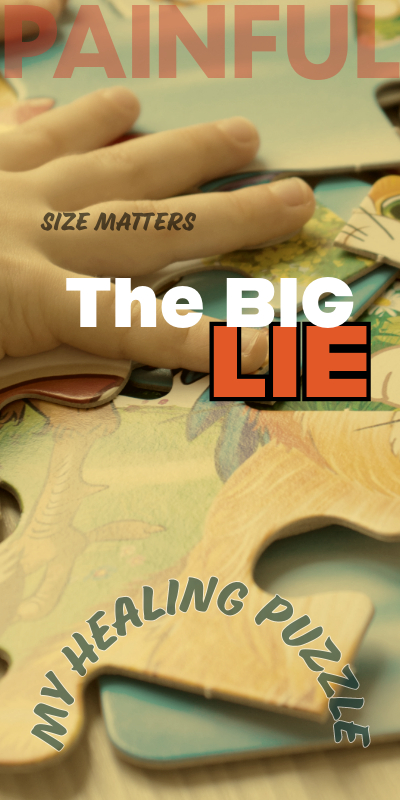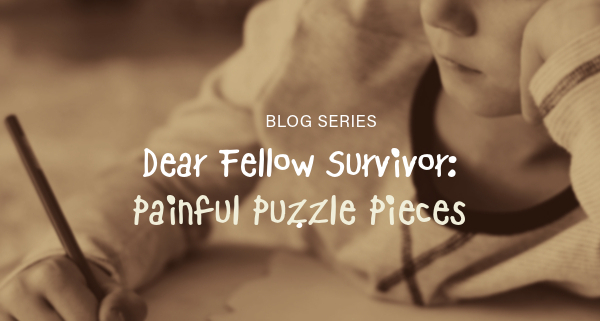Dear Fellow Survivor Blog: Painful Puzzle Pieces
Summary
This is a blog post series by the author who wrote the devotion series "Dear Survivor". Follow along as he blogs about the background of his experience on his continued journey of healing.
Sensitive content advisory: The following post talks about my concern over the size of my male member and repeatedly uses the anatomical term for that body part.
Dear fellow survivor,
In my last post, I mentioned the fact that a horrible lie has held me prisoner for almost four decades. It was a lie that I believed with my whole heart. It was a lie that exerted power over every area of my life. It was a durable lie that resisted any sort of rational argument or rebuttal. It was a lie that caused me unceasing, excruciating pain.
I’m sure that you, as a fellow survivor, can relate. I would guess that there are lies that are holding you prisoner, affecting every area of your life, resisting every rational argument or rebuttal, and causing you unceasing, excruciating pain. Before we go any further, take a moment to think about what those lies are. How have they affected you? How long have they held you prisoner?
Today, I want to be very candid with you. I’m going to tell you explicitly what the lie is that has mercilessly held me prisoner for all these years. I will also tell you about the many pieces of the puzzle that had to fall into place for me to finally experience the loosening of this lie’s grip on me. I hope that by walking you through my journey, you will find hope and encouragement for your struggle against the lies holding you prisoner.
Here’s the specific lie that has imprisoned my mind ever since I experienced sexual abuse: Penis size means something.

That lie planted itself in my mind as the abuse was happening. The person who abused me wasn’t that much older than I was at the time of the abuse. But he had already gone through puberty, while I had not. (I went through puberty about two years later than most other boys my age.) His body, including his penis, had already developed. Mine had not. And so, when I looked at the two of us, I saw a huge size difference.
My fourteen-year-old mind desperately searched for something that would lead it to safety, something that could guarantee that nothing like this abuse would ever happen again. The solution it landed on was penis size. If my penis was large enough in comparison to other guys’ penises, then I would be safe.
As I mentioned at the outset, this lie has held me prisoner for almost forty years and has affected every area of my life, from my self-perception to my relationships with my friends to my marriage. This past weekend, though, something unexpected happened. I began to feel that the lie FINALLY was starting to lose its grip on me. I’m not saying that the lie is entirely gone. It’s still lurking around and causing plenty of trouble. But it no longer seems to have the iron grip on my mind that it had even just a week ago.
This experience has been very strange. The only way I can describe it is that, after all these years, a lot of painful puzzle pieces have finally fallen into place. All the pieces had been there before, accumulated at various times over the years. But it wasn’t until this weekend that they all seemed to snap into place together. And, as I think of all these pieces of the puzzle, I am convinced they all were necessary.
I compiled a list of the pieces of my healing puzzle that had to come together to finally be where I am now. As you read through this list, think about how many of the pieces of my puzzle resonate with your own healing puzzle.
- It all started when my wife convinced me to see a therapist. She knew something was wrong and that I needed to talk to someone to explore what was happening in my mind. This was a scary step for me to take. I knew it would require me to talk about thoughts, experiences, and beliefs that I had NEVER discussed with anyone else. Perhaps you share my initial apprehension about talking to a therapist. I can tell you, however, that going to see my therapist was one of the best things I’ve ever done. He gave me a safe place to talk about all the things that were troubling me—and about a whole lot of things that I didn’t know were troubling me. I would not be where I am today if I hadn’t sought the help of a therapist.
- With the help of my therapist, I finally was able to call what had happened to me sexual abuse. I began to understand that it was not my fault. And I was able to see that the abuse helped explain why I developed such a profound body dysmorphia.
- At this point, I did some things I now realize were unhealthy. I asked my college roommate (who had seen me naked when we roomed together) if he thought my penis was normal size. He assured me that throughout the years we roomed together, he never, ever thought that I was anything other than normal. At the same time, I repeatedly measured myself in an attempt to prove to myself that, statistically speaking, I truly was normal. Neither of these things were healthy. But they happened. And I now can see that they, too, were pieces in my healing puzzle.
- Because one of my fears was that my wife would be dissatisfied with my body, I asked her what she thought. She repeatedly assured me that she was not in any way disappointed with me or my body.
- I gathered around me a band of brothers willing to help me carry my burden. I shared with them my story, my fears, and my insecurities.
- My therapist helped me see that the underlying issue NEVER really was size. It was ALWAYS about safety. Fear of being harmed again lay at the root of ALL of this.
- My therapist helped me come alongside my young self and help him face his fear. I learned that it was ok to be afraid. My fears were reasonable, given my experiences. I resolved that Young Me and Old Me would face these fears together.
- I began to realize that the size of my penis has ABSOLUTELY NOTHING to do with safety. No other man was a threat to me, regardless of how big I thought he was. I learned that I could feel less threatened if I engaged with those other guys and experienced the fact that they were not a threat to me.
- I realized that my friends had never been a threat to me. They were fighting for me even when I didn’t know it. They were on my side and never would harm me.
- I realized that I was not powerless and showed my young self that he was not powerless.
- My therapist helped me realize the importance of involving my body in my recovery. I started lifting weights at the gym. I discovered that physical movement really does have a profound effect on a person’s mental health. God designed our bodies and minds to work together. [You might consider trying some physical movement, such as exercise or yoga, as a part of your healing journey. God designed your body and mind to work together as well.]
- It occurred to me that part of what was hindering my healing was the fact that, mentally, I had not progressed past the stage of puberty I was at when the abuse happened. Physically, my body had completely caught up. Mentally, I was stuck. I now know that this is a common experience for survivors of childhood sexual abuse. Although my body had gone through puberty decades ago, mentally, I needed to go through puberty again. Soon, my mind could move past the point of constantly seeing myself as a small, pre-pubescent boy. I began to see myself as a grown man, just like all the other grown men who had made me feel threatened for so long.
- The next step was not thinking so much while working out. I was moving my body but still was thinking WAY too much. Too much thinking is dangerous for me since I tend to fixate on my fears and intrusive thoughts. I needed to learn to dismiss those thoughts quickly and physically move on.
- Next, I learned that moving my body doesn’t require me to go to the gym. I can move my body as I solve a Rubik’s Cube. That activity would both focus my mind and calm my body whenever I felt threatened by fear or intrusive thoughts.
- Then came the piece that snapped into place this past weekend. So many of my fears and insecurities had to do with what OTHER people thought about me, whether that was my friends, other guys, my wife, or a potential abuser. But what THEY thought really didn’t matter at all (except, perhaps, for what my wife thought—but I now knew what she thought). What mattered was what I thought. So, could I come up with any reason why penis size truly mattered TO ME anymore? I realized that, no, I couldn’t. Penis size truly meant nothing to me because it was not at all related to any of the things that were important to me: being a child of God, being safe, and being a good husband to my wife. I could finally recognize the lie for the lie that it always was. Whenever the lie tried to reassert itself in my mind, I now had a strategy for overcoming it that actually worked: I could use the truth to quickly dismiss it—without arguing with it—and then DO something (like solving a Rubik’s Cube).
 I’m sure there are other puzzle pieces I left off that list. But I don’t think I could have reached the point where I am now if I hadn’t experienced ALL those pieces—even the pieces that were not in themselves completely healthy. It would have been nice if I could have gone directly from Piece 1 to Piece 15 and skipped Pieces 2-14 entirely. But that’s not how this works. The puzzle of healing has A LOT of pieces, and all of them are necessary for the entire puzzle to come together.
I’m sure there are other puzzle pieces I left off that list. But I don’t think I could have reached the point where I am now if I hadn’t experienced ALL those pieces—even the pieces that were not in themselves completely healthy. It would have been nice if I could have gone directly from Piece 1 to Piece 15 and skipped Pieces 2-14 entirely. But that’s not how this works. The puzzle of healing has A LOT of pieces, and all of them are necessary for the entire puzzle to come together.
It reminds me a lot of solving a Rubik’s Cube. I’ve learned the different combinations of moves necessary to put each piece of the cube in its proper place. A lot of those moves don’t make sense all by themselves. But together, they lead to the solution. And if you miss even one move, not all of the pieces will wind up where they need to be. Similarly, not all of the pieces in my healing puzzle have made sense. Some of them have made NO sense. All of them have been painful. But I am convinced that ALL of them were necessary. And, as painful as they all were, I am now grateful for them all.
I’ve written in such detail about the painful pieces of my healing puzzle in the hope that my experience can encourage you. I do not know what all the pieces of your healing puzzle are. Perhaps some of the pieces in my healing puzzle are the same as the pieces in your healing puzzle. I’m sure, however, that many of the pieces in your healing puzzle are different (especially if you are a woman). But regardless of how similar or dissimilar our healing puzzles are, I hope you can take the following things from my puzzle and apply them to your own puzzle.
- It’s OK for you not to know what all the pieces of your healing puzzle are. I discovered new pieces to my puzzle with each step on my journey. I didn’t know ahead of time what all the pieces would be. I don’t even know right now what all the pieces of my puzzle will be. There still are more pieces to discover and more to fall into place. But that’s OK. You do not need to have everything figured out to start putting together your puzzle pieces.
- It’s OK for you to wonder whether all your puzzle pieces will ever come together. I’ve wondered that, too. I’ve wondered that a lot. There were all kinds of times when I wondered whether it was even worth it to try to find the pieces to my puzzle, let alone try to put them all together. The journey, however, is important. Puzzle pieces can’t be put together unless they are found, and they can’t be found unless you start working toward finding them.
- Putting together puzzle pieces does not happen in a straight line. You know this if you’ve ever put together a jigsaw puzzle. You start with a corner. Then, you move to an edge. Then, you work on a part in the middle. And while you’re working on it, it looks like a complete mess. But you’re still making progress with each piece you find and put into place. Your healing puzzle is very similar. You start with one piece. Then you move to another. And then you find another piece that seems totally unrelated. And everything looks like a complete mess. But it’s not. It’s a puzzle that’s slowly coming together. And you’re making progress simply by finding pieces, even if you don’t quite know where to put them yet.
- Don’t worry if every piece doesn’t exactly get you to where you want to be. Not every piece in my healing puzzle was healthy. In fact, there are pieces to my puzzle that would be harmful if I went back to them now. But they served their purpose at the time. God can take even the unhealthy pieces of our puzzles and work them out for our good.
- God does have a solution to your healing puzzle. You’ll find that solution in Jesus. Even if you feel as if the pieces of your puzzle will never, ever come together, you already are whole in Jesus. In him, you have no piece missing. While on this earth, you will not fully enjoy every aspect of being complete in Jesus. But a time is coming when you will. Ultimately, God will bring every piece of your puzzle together and show you how perfectly they fit together in Jesus.
My healing puzzle is not yet complete—and neither is yours. Assembling all the pieces of our healing puzzles will continue for the rest of our lives. Yet, I am encouraged by the still incomplete portrait that I am beginning to see in these pieces of my puzzle that already have come together.
There I see, not a broken and abused boy, but a child of God and a strong, grown man.
You can look into your healing puzzle and be encouraged by what you see as well. There you will see not who you once thought you were but who you really are in Jesus—a dearly loved, wondrously made, uniquely gifted, infinitely valuable, strong, and victorious child of God. Find hope and joy in that slowly developing portrait because that truly is who you are.
In Christ,
Your Brother Survivor
- Dear Fellow Survivor Blog: Coming Out into the Real World
- Dear Fellow Survivor Blog: There’s No Google Maps for This
- Dear Fellow Survivor Blog: Living with a co-existing condition
- Dear Fellow Survivor Blog: The Gift of Vulnerability
- Dear Fellow Survivor Blog: Painful Puzzle Pieces
- Dear Fellow Survivor Blog: Leaning on my brothers
- Dear Fellow Survivor Blog: Sharing My Burden
- Dear Fellow Survivor Blog: About Me




